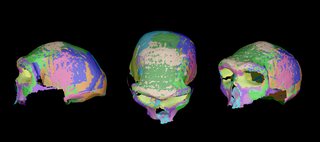Gallery
Gallery
Hear No Evil, See No Evil, Speak No Evil

Media Details
Created 10/12/2004
These images represent partial reconstructions of a fossil skull of a Homo heidelbergensis individual from Broken Hill (Kabwe) in Zambia, Africa. Discovered in 1921 by lead and zinc miners, this skull was the very first fossil of a human ancestor ever found in Africa. Possibly associated animal bones suggest the cranium may be around 400,000 years old. Homo heidelbergensis is a species thought to be ancestral to both anatomically modern Homo sapiens and Neandertals, as specimens included within this taxon combine primitive features, including ones that are retained in anatomically modern humans, with derived features that distinguish Neandertal individuals. The original skull is housed at the British Museum of Natural History in London, England. The cast used for this study is owned by the Department of Anthropology, here on the Champaign-Urbana campus. The 3D reconstruction pictured here was acquired through use of the ITG's ShapeCam by Eyetronics Corporation. Using a modified flash unit, the Shapecam projected a calibrated shadow-grid onto the surface of the skull, recording the result with a high-resolution digital camera. The ShapeSnatcher software analyzed the visible grid deformations, and produced an accurate 3D surface. By taking multiple pictures from varying angles, the ShapeSnatcher software produced a series of surface patches covering a substantial portion of the skull. The ShapeMatcher package pieced together these patches (represented by a variety of colors in this image) resulting in a near-complete reconstruction. Not pictured is the texture map of the skull's surface which is acquired during the initial photographing and automatically mapped to the surface of the skull if desired.
Credits
- Jodi Blumenfeld , Department of Anthropology